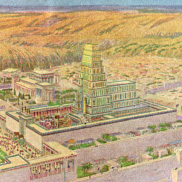|

|
The idea that freemasons of the world should unite to rebuild the Temple, or that they intended to do so, dates from the early twentieth century. Here is one masonic response, laughing at the very concept.
|
|
|
|
Freemasons as builders
Not long ago a suggestion was made that the Freemasons of the world should unite in rebuilding the Temple of Solomon at Jerusalem. Exaggeration is said to be the basis of American humor. It was doubtless In a spirit of wild and extravagant "humor" that the project was broached. Of a certainty it has been accepted in that spirit by those who are familiar with freaks of the Yankee imagination. It has not been taken seriously by Freemasons anywhere, because Freemasons know the proposition to be absurd on its face.
To the profane, however, almost any wild and improbable project attributed to the Masons seems credible, and the Illustrated London News [Aug. 28 1909] gravely discusses the plan, estimating the prodigious cost involved, and questioning whether the Mohammedans could be induced to give up the site, which is now occupied by the Tareim-Esh-Shereef, "the noble sanctuary." The London picture paper is evidently unfamiliar with American humor.
For the Freemasons of the world to attempt to duplicate the Temple erected by Solomon on Mount Moriah is a scheme as wild and impracticable as were the crusades initiated by Peter the Hermit. In this matter-of-fact age the fine enthusiasms that induced men to sacrifice all that they hold dear for an idea do not exist. And the perfect organization and admirable discipline that we are taught prevailed among the workmen at the building of the first Temple is impossible among the speculative builders of to-day.
As speculative Masons we are builders of character, utilizing the symbols of the operative craft to teach lessons of self-control and benevolence. When we attempt a practical exemplification of those lessons, when we try to build even an ordinary, modern Temple such as business corporations erect, as a matter of course, we fall wofully short of the ideals which we have set for ourselves.
The most valuable lesson which is to be derived from the building of King Solomon's Temple is the lesson of harmony among the workmen. It is the most needful lesson in the present stage of our development. We Americans have cultivated individuality and independence to such an extent that we have lost the discipline, the solidarity, which is necessary to united effort. Our organization is the merest thread. We are held together by sentiment, and when the tie that binds becomes tiresome in the slightest degree, we break it without compunction. When we erect a Temple we emulate the discordant elements of Babel, rather than the harmonious discipline of Solomon.
We have great faith in Freemasonry as a speculative institution, but from our knowledge of the Freemasons of this age and country, we deem them much better fitted, by training and temperament, to engage in an enterprise like that on the plains of Shinar which resulted in that confusion of tongues, than to rebuild the House of the Lord.
Reprinted from Masonic Standard, C.C. Hunt, President, Treasurer, Editor and Manager. New York. October 9, 1909, p. 8.
King Solomon’s Temple—View from the northeast corner. Plate 6. The Bible and
King Solomon’s Temple in Masonry, by John Wesley Kelchner. 1951: A. J. Holman
Company, Philadelphia. A scale model based on Kelchner’s research and constructed by Albert Wesley Hilt in 1923 for the Holman Bible Company was displayed at the New York World’s Fair in 1960 and resided for many years in the Grand Lodge of Pennsylvania museum.
|
|
|